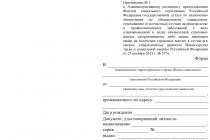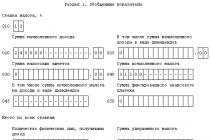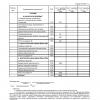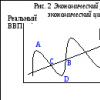The organization of accounting in a company should begin with the definition of a taxation system. This choice affects not only the size tax liabilities and frequency of reporting, but also the procedure for making payments to the budget. Features of interaction with the Federal tax service and budgets should be fixed in a special document.
How to compose for OSNO
With a general system in the accounting policy for tax purposes, you should write out:
- The method of accounting for income when calculating income tax (cash or accrual method).
- Method for determining the value of fixed assets, inventories and goods.
- Depreciation method for fixed assets and intangible assets.
- The possibility of forming reserves for income tax, vacations and doubtful debts.
- Forms and forms tax registers: unified or developed independently.
Regional and local authorities have the right to establish reduced tax rates, approve additional benefits or completely exempt from payment. When compiling, be guided not only by federal legislation, but also by the regulatory legal acts of subjects and municipalities.
How to compose with simplification
The simplified taxation system, according to the rules of the current legislation, provides for two types of accounting for enterprise income:
- "income" - the tax base is the total income for the reporting period, excluding expenses incurred;
- "income minus expenses" - the basis for calculating the liability is determined as the difference between total receipts and expenses.
Consider distinctive features in the table:
|
Index |
"Income" |
"Income minus expenses" |
|---|---|---|
|
Object of taxation |
If the accounting policy of NPOs on the simplified tax system (as well as for commercial enterprises) assumes the object of taxation "income", then when determining the payment, the organization takes into account only the receipt of funds. |
We prescribe "d - r", that is, when calculating obligations, we take into account the receipts of funds reduced by expenses. |
|
If the institution next reporting period plans to change the object of NO, then a notification to the Federal Tax Service is sent no later than December 30 current year(clause 2 of article 346.14 of the Tax Code of the Russian Federation). |
||
|
tax rate |
It is not necessary to specify, since the rate is the same for this type of taxation - 6%. |
The rate is 15% for all taxpayers. |
|
The condition is relevant only if the regional authorities have reduced the tax rate. Otherwise, it is not necessary to indicate the size of the rate in the UE (clauses 1 and 2 of article 346.20 of the Tax Code of the Russian Federation). |
||
|
Income and expense ledger |
If the institution has chosen electronic record keeping, determine the order of printing, numbering, stapling of pages and their certification. Also fix the person responsible for storing the document. |
|
|
Cost accounting |
Not applicable. |
Companies on the simplified tax system are eligible to reduce the income of this reporting period for losses of previous years (clause 7 of article 346.18 of the Tax Code of the Russian Federation). You can use the condition if the company in the unprofitable period was on the simplified tax system "d - r". Minimum tax. The Company has the right to take into account as expenses the difference between the listed minimum tax and the tax calculated in in the usual way. Such conditions are spelled out in paragraph 6 of Art. 346.18 of the Tax Code of the Russian Federation. |
In accordance with the current legislation, accounting in a non-profit organization must be maintained on the basis of an accounting policy formed in accordance with the Regulation on accounting « Accounting policy organizations” PBU 1/98, approved by Order of the Ministry of Finance Russian Federation dated December 9, 1998 No. 60n “On Approval of the Accounting Regulation “Accounting Policy of the Organization” RAS 1/98” (hereinafter RAS 1/98).
When forming an accounting policy, an accountant public organization it should be assumed that it should first of all reflect all the accounting methods used in a given organization, on those issues for which the legislation provides for several possible accounting options or for which accounting methods at the regulatory level do not exist at all. installed.
The accounting policy of an enterprise is the main internal document that regulates the accounting and reporting procedures in a public organization.
Public organizations should remember that the accounting policy should be presented as a document that allows reducing the tax and accounting burden of today.
Accounting policy public association formed in
in accordance with PBU 1/98. RAS 1/98 defines the basic principles for the formation and disclosure of an organization's accounting policy.
Article 6 federal law dated November 21, 1996 No. 129-FZ “On Accounting” the accounting policy is developed by the chief accountant (accountant) and approved by order or order of the head of the public association.
It affirms:
This discrepancy is faced by the accountant of a non-profit organization, when one after another there are issues of accounting for the paid value added tax, the acquisition and depreciation of fixed assets, the formation and expenditure of targeted funds.
Expansion of the scope of activities commercial organizations increased the number of accounting problems.
There are questions about the distribution of costs, in the presence of entrepreneurial activity, accounting exchange differences and others. All this leads to the fact that accountants come up with accounting schemes that are not confirmed in regulatory documents.
The situation is also complicated by the tax authorities.
Based on this, it is necessary to develop an integrated accounting system as soon as possible. non-profit organizations covering all aspects of their activities from cash operations to reporting.
We draw your attention to the fact that such a system can be formed only by defining conceptual framework accounting, that is, that representation, understanding of the purposes of accounting, on the basis of which, will be formed.
The proposed concept is that, based on the system budget accounting, approved by the Order of the Ministry of Finance of the Russian Federation dated December 30, 1999 No. 107n "On approval of the accounting instructions in budgetary institutions" (losing effect from October 1, 2005), adapt it to the Order of the Ministry of Finance of the Russian Federation dated October 31, 2000 No. 94n " On approval of the chart of accounts for financial accounting economic activity organizations and instructions for its application”, to be supplemented taking into account the specifics of the activities of non-profit organizations, and ultimately to obtain a schematically completed accounting methodology. The main advantage of this approach is the use of a basic model focused on accounting for the movement of target funds. That is, the reflection of all transactions in accounting is modeled in terms of completeness and timely reflection formation and use of such funds.
The budget accounting system provides for the existence of several sub-accounts for accounting for spending funds:
200 cost estimates;
210 expenses to be distributed;
220 business expenses.
Sub-account data in budget plan accounts are similar to the accounts of financial and economic activities of organizations number 20 "Main production", 25 "General production costs", and 23 "Auxiliary production".
Of greatest interest is the budget sub-account 210 "Costs for distribution". In accordance with the Order of the Ministry of Finance of the Russian Federation dated December 30, 1999 No. 107n “On Approval of Instructions for Accounting in Budgetary Institutions”. This sub-account takes into account expenses that, at the time of their occurrence, cannot be attributed directly to one or another source of funding. At the end of the reporting period, these amounts are distributed in proportion to the occupied space, the number of contingents or sources of funding.
A typical situation when it is necessary to use such an account is the situation when paying for the rent of premises in the presence of entrepreneurial activities in non-profit organizations. It should be noted that when considering the distribution of costs of non-profit organizations in the presence of entrepreneurial activity, an analogy with budgetary organizations is increasingly being drawn in the literature.
So, using the cost accounting methodology defined for budget institutions and a chart of accounts for self-supporting organizations, expenses for distribution in the accounting of non-profit organizations should be reflected in the debit of account 26 “General business expenses”.
Negative differences:
In accordance with Article 26 of the Law on Non-Commercial Organizations, the source of financing for the property of a non-commercial organization may be:
· regular and one-time receipts from the founders (participants, members);
· voluntary property contributions and donations;
· proceeds from the sale of goods, works, services;
· dividends (income, interest) received on shares, bonds, other securities and deposits;
· income received from the property of a non-profit organization;
· other receipts not prohibited by law.
To account for incoming funds, the Chart of Accounts provides for the “Target financing and receipts” account.
The expenditure of targeted revenues must be made in accordance with the goals and objectives of the non-profit organization.
The main issue that does not have an unambiguous solution today is the choice of the method for reflecting operations on account 86 “Target financing” - the cash method or the accrual method.
The extensive practice of applying by non-profit organizations of the classic account 86 "Targeted funding" combines two ways:
Cash method of accounting for income Money,
Combination of methods when spending funds. So cash expenses written off as a matter of fact, and the cost of wages accrual method.
The current regulatory documents do not directly regulate the use of one or another method in relation to the formation of the "Target Financing" account. In the comments or instructions, the wording “received funds” is used, that is, the use of the cash accounting method is implicitly provided.
If you turn to international practice, then international standards provide for the maximum possible use of the accrual method for recording transactions in accounting accounts.
An example is the international standard financial reporting IAS 20 on the accounting for government grants.
The standard provides for two approaches to reflect revenue:
If the receipt does not include expenses (usually these are subsidies in the form of an asset), they can be applied on a cash basis (for example, a bus was transferred to a non-profit organization, such a transaction should be recorded after it is committed);
If the income involves spending or covering expenses already incurred (usually cash grants), the accrual principle should be applied.
However this method can only be applied if:
Where there is reasonable certainty that such subsidies will be received;
If the organization satisfies the conditions for issuing such subsidies.
These provisions international standard can be extended to accounting for targeted funds of non-profit organizations. That is, when generating account 86 “Target financing”, you can apply the accrual method if, at the reporting date, the organization has facts confirming the allocation of funds to it from the appropriate source.
For more information on the issues of accounting and taxation of non-profit organizations, you can find in the book of CJSC "BKR Intercom-Audit" "Non-profit Organizations".
Goals of developing an accounting policy
The accounting policy of any organization is drawn up in order to determine in it the main methodological aspects that the legal entity will focus on when conducting accounting operations. This need is caused by the fact that in some cases legally established options for accounting methods are provided, the choice of which must be made independently, taking into account the preferences and specifics of the activities of a particular legal entity. If the method of accounting for an existing object is not established by law, it should be developed, and the result of the development should also be fixed in the accounting policy.
The accounting policy will be in demand not only by inspectors. It is important primarily for the user himself, since it reflects all the features of the methodology he independently chose (clause 5.1 of PBU 1 / 2008, approved by order of the Ministry of Finance of Russia dated 06.10.2008 No. 106n).
Non-profit organizations (NPOs) are not an exception in this regard, since they, as well as other legal entities, are subject to (Law "On Accounting" dated 06.12.2011 No. 402-FZ) duties:
- for accounting (clauses 1, 2, article 5);
- development of an accounting policy (clause 2, article 8);
- preparation of accounting records (clause 2, article 13).
Moreover, the choice of existing ways NPOs in a number of situations are wider than other organizations.
Specifics of NCO accounting policy
A special accounting policy developed in non-profit organizations becomes due to the following points:
- an NPO may have no commercial activity at all, in which case there is no need to develop a tax accounting policy;
- NCOs (other than those subject to mandatory audit and included in the register of foreign agents performing the functions) can apply simplified accounting methods and draw up simplified accounting (subparagraph 2, paragraph 4, article 6 of Law No. 402-FZ);
ATTENTION! Simplified accounting methods are established federal standard(Article 21 of Law No. 402-FZ). There is no such standard at the time of writing. But work on its development is already underway. The expected date for the entry of the standard for non-commercial activities is 2021 (Order of the Ministry of Finance dated 05.06.2019 No. 83n).
Don't know your rights?
- there are PBUs that are not subject to use by NCOs (13/2000, 20/03);
- NPOs that have chosen to simplify accounting have the right not to apply a number of PBUs (2/2008, 8/2010, 11/2008, 12/2010, 16/02, 17/02, 18/02) and the right to use both these PBUs and and all others, including NPOs, with certain features;
- NPOs that conduct commercial activities along with non-profit, as well as commercial organizations, have the right to choose the system of taxation applied to income from sales, and methods tax accounting from existing for the selected system;
- for NGOs with certain areas of activity, methodological recommendations can be developed that take into account the specifics of this activity.
These features not only expand the number of accounting methods available to NCOs, but also create the prerequisites for the formation of a completely unique accounting policy for each specific organization. Moreover, despite the legally established possibility of simplifying a number of accounting procedures, the text of the accounting policy of an NPO itself may turn out to be more voluminous than that of a commercial organization.
What to reflect in the NPO accounting policy for 2020
An accounting policy intended to be applied in 2020 should reflect all significant current situation to organize the moments and describe them in detail (without ambiguity). The detail of the presentation is especially important, since the accounting policy is the main document that must be followed in the accounting work conducted in the legal entity for which it was drawn up.
When forming the current accounting policy, it is necessary to use the current version of Law No. 402-FZ, the Tax Code of the Russian Federation, applicable to PBU NCOs and other regulations. Links to specific paragraphs and articles of these documents may be provided in the text of the accounting policy for the convenience of the user.
The rules set out in the accounting policy of NCOs for 2020 are designed to long term(clause 5 PBU 1/2008), That is, the document may continue to be valid in subsequent years. If some provisions require changes or new objects appear, the accounting rules for which are not reflected in the current accounting policy, its text can be changed or supplemented with a separate organizational and administrative document.
A sample NCO accounting policy, compiled using the regulations valid in 2020, is given below:
Accounting policies for NCOs are mandatory, as for any other organization. However, it is compiled taking into account the specifics of the activities of NPOs and the possibility of using simplified accounting, which allows, with certain reservations, to apply those PBUs that apply to NPOs. The accounting policy should be applied consistently from year to year, therefore, its provisions developed for 2020 may also be valid in subsequent years, unless legally justified changes to them or additions are required due to the appearance of objects, the accounting rules for which are not described in the applied accounting policy. were.
Non-profit organizations: accounting features and accounting policies
Non-profit organizations: accounting and accounting policy
Cherkasova Galina Vladimirovna,
Candidate of Economics, Associate Professor
FROM [email protected]
Zaikina Oksana Petrovna
Candidate of Economics, Associate Professor
FSBEI HE Orenburg State Agrarian University
Annotation. The results of studying the features of the organization of accounting in non-profit organizations are presented. Recommended elements of the accounting policy of non-profit organizations for the purposes of accounting and tax accounting have been developed.
Keywords.Accountingnon-profit organization in the implementation of statutory and entrepreneurial activities, accounting policy elementsnon-profit organization for the purposes of accounting and tax accounting.
abstract.Presents the results of studying the peculiarities of accounting in non-profit organizations. Developed the recommended elements of the accounting policy of non-profit organizations for the purposes of accounting and taxation.
keywords.Accounting non-profit organization in the exercise of statutory and business, the accounting policies of the non-profit organization for the purposes of accounting and taxation.
AT modern conditions non-profit organizations (NPOs) can be created to achieve various goals aimed at creating public goods. The activities of NPOs are determined by the following principles: socially useful and non-profit nature of activities; spending profits on the provision and development of statutory functions; the use of strictly defined sources in the formation of property; diversity in the provision of public goods. NCOs are classified: by the form of ownership; the rights of founders (participants) in relation to non-profit organizations or their property; the presence of the institution of membership; presence foreign element; territorial area of activity.
According to paragraph 3 of Art. 50 of the Civil Code of the Russian Federation, non-profit organizations have the right to engage in entrepreneurial activities with the obligatory observance of the requirements: the activity must serve the achievement of statutory goals; the nature of the activity should be consistent with these goals.
Features of capital formation; procedures for creating a legal entity; the procedure for carrying out business activities; ownership of property; the procedure for distributing profits; the procedure for managing a legal entity; the scope and procedure of liability for its obligations to third parties; the procedures for liquidating a legal entity determine the peculiarities of accounting and reporting in an NPO.
It should be noted that the NCO accounting methodology is one of the contemporary problems reforming accounting in the Russian Federation. Interest in the problem is due to the fact that not developed regulations governing accounting in NCOs. NPOs use regulatory documents on accounting for commercial organizations, which is not entirely legitimate, since it is impossible to transfer all the accounting provisions of commercial organizations to NPOs. Much attention is paid to the problems of accounting in NCOs in the works of Gusarova L.V., Jamalova G.G. , Myakinina L.N. , Semenikhina V.V. , Yagudina G.G. and others, but there is no consensus on a number of accounting issues. Given the variety of forms and types of non-profit organizations, from the point of view of accounting organization, it is advisable to divide them into two groups, the first includes organizations that receive and distribute earmarked funds, but do not conduct commercial activities, the second - organizations that, in addition to the statutory ones, are engaged in commercial activity. The expansion of the scope of activities of non-profit organizations determines the features of accounting. Accounting records of NPOs are maintained on the basis of an accounting policy formed in accordance with PBU 1/2008, which reflects all methods of accounting, on those issues for which the legislation provides for several possible options for accounting or for which methods of accounting at the regulatory level have not been established at all. The study of the accounting system in NPOs made it possible to identify and summarize the features of accounting and the formation financial statements in the implementation of statutory and entrepreneurial activities (table 1).
Table 1 - Features of the organization of accounting and the formation of financial statements in NCOs
|
Peculiarities |
|
|
1. Normative regulation of accounting in NCOs |
|
|
1.Organization of accounting |
carried out in accordance with Federal Law No. 402-FZ "On Accounting" |
|
2. Accounting policy |
is formed in accordance with PBU 1/2008 "Accounting policy of the organization" |
|
3. Chart of Accounts |
the Chart of Accounts for accounting of financial and economic activities of enterprises and the Instruction for its application approved by the Order of the Ministry of Finance of the Russian Federation dated October 31, 2000 No. 94n are applied |
|
4. Accounting regulations |
They are applied taking into account the specifics of the activities of NGOs |
|
5. PBU not applied by NCOs |
PBU 11/2008 "Information on related parties", PBU 13/2000 "Accounting for state aid", PBU 20/03 "Information on participation in joint activities" |
|
6. PBUs that NCOs may not apply |
23/2011 "Cash flow statement", 2/2008 Accounting for construction contracts”, 7/98 "Events after the reporting date", 8/2010 " Estimated liabilities, contingent liabilities and contingent assets”, 12/2010 "Information on segments", 16/02 "Information on discontinued operations", 17/02 "Accounting for R&D expenses", 18/02 "Accounting for income tax expenses" |
|
7. Formation of financial statements |
carried out in accordance with PBU 4/99, Order of the Ministry of Finance of the Russian Federation dated July 2, 2010 N 66n "On the forms of financial statements of organizations" and Information of the Ministry of Finance of the Russian Federation "On the features of the formation of financial statements of a non-profit organization" (PZ-1 / 2011) |
|
8. Formed reporting groups |
financial statements, tax reporting, statistical reporting, reporting to state off-budget funds; special reporting; |
|
9. Annual set of financial statements |
includes a balance sheet; Report on financial results; cash flow statement; Report on intended use funds received; explanatory note |
|
Organization of NCO accounting |
|
|
10. Accounting for targeted funds for statutory and entrepreneurial activities |
conducted using account 86 "Target financing" |
|
11. Accounting for targeted income in accounting |
carried out at the time of actual receipt of funding |
|
12. Account 86 "Target financing” is detailed by type of income |
86.1 "Proceeds from statutory activities"; 86.2 "Receipts from entrepreneurial activities" |
|
13. To account 86 open sub-accounts of the second order |
to detail funding sources by types of targeted programs |
|
14. Cost accounting |
conducted using accounts 20 "Main activities", 26 "General expenses" |
|
15. Allocation of sub-accounts to accounts 20, 26 |
1 - expenses for statutory activities 2 - business expenses |
|
16. Method of distribution of indirect costs |
is fixed in the accounting policy - based on the share of receipts for the program |
|
17. Accounting for business income |
carried out in accordance with PBU 9/99 "Income of the organization", conducted using accounts 90 "Sales", 91 "Other income" |
|
18. Financial result from entrepreneurial activity |
reflected on account 99 "Profit (loss)" |
|
19. Use of net profit |
Profit from entrepreneurial activity is taken into account as a source of statutory activities |
|
20.Expenses at the expense of earmarked funds |
carried out within the budget |
|
21. Accounting for business expenses |
carried out in accordance with PBU 10/99 "Expenses of the organization" |
|
22. Accounting for expenses on loans and borrowings |
carried out in accordance with PBU 15/2008 "Accounting for expenses on loans and credits" |
|
23. Other income from non-entrepreneurial activities: -penalties; - disposal of fixed assets and other |
reflected on account 91 "Other income and expenses" |
|
24. Accounting for fixed assets |
carried out in accordance with PBU 6/01 "Accounting for fixed assets" |
|
25. Assets worth less than 40,000 rubles. |
accounted for in inventories |
|
26. Depreciation of fixed assets is not charged |
Depreciation is accrued on the off-balance account 010 in a linear way |
|
27. Accounting for wealth |
carried out in accordance with PBU 5/01 "Accounting for inventories" |
|
28. Write-off of material assets |
carried out in one of the ways: the cost of each unit; according to the FIFO method; at average cost |
|
29. Leading cash transactions |
|
|
30. Inventory of property and liabilities |
carried out before the preparation of annual financial statements |
|
Taxation of NGOs |
|
|
paid: income tax; VAT |
|
|
32. If there is an object of taxation |
paid transport tax, corporate property tax, land tax |
|
33. As part of the implementation of activities under the simplified taxation system |
Tax is paid according to the USN |
|
34. As part of the implementation of activities on UTII |
Paid single tax according to UTII |
The study showed that NCOs use accounting documents that regulate accounting in commercial organizations, despite the specifics of accounting.It is known that the accounting policy is formed by an individual choice of accounting methods, and in view of the fact that they are not established by standards for NCOs, the organization has the right to independently develop the relevant elements, guided by the requirements of legislation and regulations. It is noted, however, that not all important aspects reflected in the accounting policy.Let's highlight the most important recommendations that were developed during the study to be included as elements in the accounting policy of NCOs for the purposes of accounting and tax accounting (Table 2).
|
Capabilities |
||
|
1. Open first-order sub-accounts for account 86 “Targeted financing” by detailing by type of income |
86.1 "Entrance membership fees"; 86.2 "Annual membership fees"; 86.3 "Voluntary contributions"; 86.4 "Targeted receipts from legal entities"; 86.5 "Targeted revenues from the budget"; 86.6 "Income from other operations"; 86.7 "Proceeds from business activities" |
Detailing allows you to control the type of income and link them to the expenses incurred |
|
2. Open sub-accounts of the second order to account 86 "Target financing" for each program |
86.4.1 "Targeted income from legal entities - for project 1"; 86.4.2 "Targeted income from legal entities for project 2", etc. |
Allows you to generate information on the use of funding sources and control receipts for each target program |
|
3. To account 20 for statutory and entrepreneurial activities to detail the direct costs of programs and projects, open sub-accounts of the second order |
For statutory activities: 20.1.1 "Material costs"; 20.1.2 "Labor costs"; 20.1.3 "Deductions for social needs" |
The detailing of direct cost items allows you to reflect information on the types of costs on the accounts |
|
4. Opening sub-accounts of the third order to account 20 allows you to reflect information on direct cost items |
For statutory activities: 20.1.1.1 "Materials"; 20.1.2.1 "Payment for hours worked"; 20.1.3.1 "FIU", etc. |
The detailing of direct cost items allows you to reflect information on selected cost items on the accounting accounts |
|
5. Account 26 "General business expenses" supplement with sub-account 26.3 - "General general running costs on statutory and entrepreneurial activities" |
Account 26.3 includes expenses to be distributed between statutory and entrepreneurial activities |
Allows you to allocate data from sub-account 26.1 to statutory activities for programs, for entrepreneurial activity by programs sub-account data 26.2 |
|
6. Select the following cost items for accounts 26.1 “General business expenses for statutory activities”, 26.2 "General business expenses for entrepreneurial activities", 26.3 "General general business expenses for statutory and entrepreneurial activities" |
1.Services: 1.1 Services third parties by type; 2. Labor costs: 2.1 Pay for hours worked; 2.2. Payment for unworked time 3. Deductions for social needs: 3.1 FIU; 3.2 FSS; 3.3 FFOMS; 3.4 Insurance against NA and PZ 4. Travel expenses; 6.Consulting expenses; 7.Publishing expenses; 8. Postage, office supplies, copying work for the needs of the office; 9.Expenses for holding general meetings; 10. Rental expenses; 11. Taxes; 12. Audit costs 13.Expenses for personnel training, advanced training |
The allocation of cost items on account 26 for sub-accounts will allow you to reflect information on cost items in accounting |
|
7. The procedure for reflecting the overspending of targeted funds |
There are 2 options: 1. Costs from accounts 20, 26 are written off to the debit of account 86 within the limits of the available targeted income. Account 86 is closed without a balance, and account 20 has a balance at the reporting date, which will be reflected in the asset balance sheet on the line "Reserves". 2. Overspending is reflected in account 86 as debit balance. In the reporting, they are reflected in the item "Target financing" in parentheses. |
Choose one of the options |
|
8. Creation of reserves: for warranty repairs; For vacation pay; For doubtful debts |
1. are formed according to the requirements; 2. not formed |
Choose one of the options |
|
For tax purposes |
||
|
9. Creation of a reserve for the repair of fixed assets |
1.when creating a reserve, the maximum amount cannot exceed the average value of the actual repair costs that have developed in the organization over the past three years; 2.reserve is not created |
Choose one of the options (Art. 260, Art. 324 of the Tax Code of the Russian Federation) |
|
10. Reserve for vacation pay |
1.when creating a reserve, the calculation is made based on the estimated annual amount vacation expenses, including the amount of insurance premiums from such expenses. 2. no reserve is created |
Choose one of the options (Article 324.1 of the Tax Code of the Russian Federation) |
|
11.Reserve for doubtful debts |
1. when creating a reserve, its value cannot exceed 10 percent of the proceeds for the reporting (tax) period. For doubtful debts with maturity: – over 90 calendar days- in the full amount of the debt; - from 45 to 90 calendar days (inclusive) - in the amount of 50 percent of the debt; – up to 45 days – no reserve is created. 2. not created |
Choose one of the options (Article 266 of the Tax Code of the Russian Federation) |
|
12. Procedure for recognition of income and expenses for income tax purposes |
1. the accrual method is used (Article 271 of the Tax Code of the Russian Federation) 2. the cash method is used (Article 273 of the Tax Code of the Russian Federation) |
Choose one of the options |
|
13.Advance payments for income tax |
1. quarterly advance payments based on the results of the reporting period (Article 286 of the Tax Code of the Russian Federation) 2. monthly advance payments (Article 286 of the Tax Code of the Russian Federation) |
Choose one of the options |
|
14. In case of combining the taxation system in the form of UTII and common system taxation |
Organization separate accounting property, liabilities and business transactions |
(Clause 9, Article 274 of the Tax Code of the Russian Federation) |
|
16. For the purpose of calculating VAT |
Separate accounting of taxable and non-taxable transactions is organized |
(Clause 4, Article 170 of the Tax Code of the Russian Federation) |
|
17. Expenses incurred in the reporting period, but relating to subsequent reporting periods |
are reflected in the financial statements as a separate item as deferred expenses |
These expenses are written off during the period to which they relate in equal installments. |
Thus, the use of the proposed itemization of accounts for accounting for costs and receiptscan be useful in organizing accounting in any NPO, while taking into account the peculiarities of their activities.
P The procedure for developing an accounting policy for an organization in the non-profit sector of the economy depends on the characteristics of its activities, and this must be taken into account.Taking into account the above, as well as the results of the analysis of various methods of accounting policies used in NCOs, the authors of the article developed the elements of accounting policies that must be included in the accounting policy. When compiling the study, the authors took elements of the methods of commercial organizations and developed their own obtained as a result of practical research.
Bibliographic list
- Civil Code of the Russian Federation (part one) dated November 30, 1994 N 51-FZ (as amended on December 6, 2011, as amended on June 27, 2012) - URL: http://www.consultant.ru/popular/gkrf1/(date of access: 29.03.2015)
- Gusarova L.V. Target financing and targeted revenues: accounting methodology // Accounting in budgetary and non-profit organizations. 2011. N 20. P.36-44
- Jamalova G.G. Accounting in non-profit organizations // Practical accounting. 2012. N 2 - URL:(date of access: 20.03.2015)
- Order of the Ministry of Finance of the Russian Federation from October 6, 2008 No. 106n"On approval of the Accounting Regulations" Accounting policy of the organization "PBU1 / 2008" -URL: http : //base.consultant.ru /cons/cgi/online.cgi?req = doc; base=LAW; n=142566/ (date of access: 20.03.2015)
- Semenikhin V.V. Peculiarities of formation of financial statements of non-profit organizations // Accounting in budgetary and non-profit organizations. 2012. N 3. S.11-18
- Instruction of the Central Bank of the Russian Federation dated March 11, 2014 N 3210-U"On the procedure for conducting cash transactions legal entities and simplified procedure for conducting cash transactions individual entrepreneurs and small businesses - URL:
- Federal Law "On Accounting"dated December 6, 2011 No. 402-FZ (as amended on December 28, 2013) - URL: http://base.consultant.ru/cons/cgi/online.cgi?req=doc;base=LAW;n=156037 (date of access: 22.03.2015)
- Federal Law "On non-profit organizations"dated 01/12/1996 N 7-FZ (as amended on 03/07/2014) - URL: http://www.consultant.ru/popular/nekomerz (date of access: 20.03.2015)
- Yagudina G.G. Accounting for the property of non-profit organizations // Accounting in budgetary and non-profit organizations. 2012. No. 7. S. 30-37.
Non-profit organizations, like commercial firms, are required to form their accounting policies for the purposes of accounting and tax accounting.
The formation of the accounting policy of any organization is significantly influenced by many factors: the purpose of its creation and the organizational and legal form, scale, structure, scope, number of personnel, and so on.
Since it is difficult to present a standard accounting policy for all existing forms of non-profit organizations, in this article we will consider the accounting policy on the example of a horticultural non-profit partnership.
First, we recall that from 01.01.2019 the Federal Law of 07.29.2017 N 217-FZ "On the conduct by citizens of gardening and horticulture for their own needs and on amending certain legislative acts Russian Federation" (hereinafter - Law N 217-FZ), which replaced the Federal Law of April 15, 1998 N 66-FZ "On horticultural, horticultural and country non-profit associations of citizens" (hereinafter - Law N 66-FZ).
For reference: Law N 217-FZ introduced appropriate amendments and additions to a number of laws, including such fundamental ones as the Land Code of the Russian Federation, the Water Code of the Russian Federation, the Housing Code of the Russian Federation, the Town Planning Code of the Russian Federation and the Civil Code of the Russian Federation (hereinafter referred to as the Civil Code of the Russian Federation).
According to paragraph 1 of Article 4 of Law N 217-FZ, owners of garden land plots or garden plots, as well as citizens wishing to acquire such plots in accordance with land legislation, can create:
- horticultural non-profit partnerships;
- horticultural non-profit partnerships.
Thus, in contrast to Article 4 of Law N 66-FZ, such forms of non-profit organizations (hereinafter referred to as NPOs) have been abolished, such as:
- dacha non-profit partnerships;
- horticultural, horticultural or dacha consumer cooperatives;
- horticultural, horticultural or dacha non-profit partnerships.
That is, one of the tasks of Law N 217-FZ can be considered the reduction organizational forms NCOs in this area up to two main ones, taking into account the purpose of land plots.
According to Article 50 of the Civil Code of the Russian Federation, a non-profit organization is an organization that does not have profit making as the main goal of its activities and does not distribute the profit received among the participants. A similar definition of NCOs is contained in Article 2 of Federal Law No. 7-FZ of January 12, 1996 "On Non-Commercial Organizations" (hereinafter - Law No. 7-FZ). I agree with this definition of NCOs and the Ministry of Finance of Russia in Letter No. 03-11-11/33481 of May 8, 2019.
Moreover, they can be created only in those forms that are directly given in paragraph 3 of Article 50 of the Civil Code of the Russian Federation.
According to article 50 of the Civil Code of the Russian Federation, non-profit organizations can be created in the form of:
consumer cooperatives, which include, among other things, housing, housing construction and garage cooperatives, mutual insurance companies, credit cooperatives, rental funds, agricultural consumer cooperatives;
public organizations, which include, among other things, political parties and trade unions (trade union organizations) created as legal entities, bodies of public amateur performance, territorial public self-governments;
social movements;
associations (unions), which include, including non-profit partnerships, self-regulatory organizations, associations of employers, associations of trade unions, cooperatives and public organizations, chambers of commerce and industry;
associations of property owners, which include, among other things, associations of homeowners, horticultural or horticultural non-profit partnerships;
For reference: as already noted, as of January 1, 2019, in connection with the amendments made by Law N 217-FZ, horticultural, horticultural and dacha consumer cooperatives have been excluded from the list of organizational and legal forms of NPOs and two forms of non-profit organizations have been introduced - horticultural or horticultural non-profit partnerships.
Cossack societies included in State Register Cossack societies in the Russian Federation;
communities of indigenous peoples of the Russian Federation;
funds, which include, including public and charitable foundations;
institutions that include state institutions(including state academies Sciences), municipal institutions and private (including public) institutions;
autonomous non-profit organizations;
religious organizations;
public law companies;
bar associations;
bar associations (which are legal entities);
public corporations;
notary chambers.
The list of NPO forms is closed and is not subject to extended interpretation.
According to paragraph 3 of Article 4 of Law N 217-FZ, horticultural or horticultural non-profit partnership is a type of association of property owners.
Clause 1 of Article 123.12 of the Civil Code of the Russian Federation determines that a partnership of real estate owners is recognized as a voluntary association of owners real estate(rooms in the building, including in apartment building, or in several buildings, residential buildings, garden houses, garden or garden plots, etc.), created by them for co-ownership, use and statutory within the limits of the disposal of property (things), by virtue of the law being in their common ownership or in common use, as well as to achieve other goals provided for by laws.














